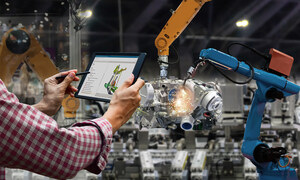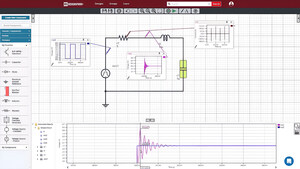Mazda drives engineering creativity using Siemens' model-based generative engineering tools
- Mazda realizes electrical and electronic design productivity and innovation using the Capital model-based generative design flow
- Capital seamlessly integrates data across multi-discipline domains, including electrical and mechanical, for unified vehicle design collaboration
PLANO, Texas, July 23, 2019 /PRNewswire/ -- Siemens today announced that Mazda Motor Corporation has adopted the Capital™ electrical design software suite from Mentor, a Siemens business, to help maximize innovation in the design of next-generation automotive electrical systems. Recognized worldwide for its successful launch of innumerable innovative technologies, Mazda uses Capital for model-based generative design for the electrical and electronic systems of the entire vehicle platform. The Capital automated generative design flow helps Mazda automotive design teams manage design complexity and changes across the entire vehicle platform, minimizing errors and reducing costs.
The development of safe and efficient electrical designs has become a critical task as the automotive industry moves towards large scale system developments such as electrified powertrains and autonomous driving. These designs are often based on entirely new architectures and have become so complex that advanced software tools are needed to enable development efforts. Capital tools deliver real time feedback against target metrics such as cost, weight, and network bandwidth consumption. This allows engineers to explore alternative design approaches, which is extremely important for large scale system developments represented by electric and autonomous vehicles. Capital software also provides Mazda with extensive simulation and verification functionalities.
At Mazda, from system design, harness design and verification down to manufacturing and service documentation, outputs of each process have been generated in its natural language, requiring designers to translate between processes and fill in the missing pieces using their talents and skills. "In order to remove ambiguity while maintaining the diversity of expressions that are characteristics of these natural languages, we applied formal methods to eliminate the loss in information transfer and set a goal to build a development environment that is consistent and connected all the way through the manufacturing phase," said Kazuichi Fujisaka, Technical Leader, Mazda Motor Corporation. "Furthermore, we also aim to shift to a development methodology that allows us to optimize the vehicle as a whole, with all possible variations being considered in the early development stage. To make this happen, we needed a development environment to visualize the entire vehicle circuitry and standardize our language, tools, and processes without compromise, creating standard models across the company. Mentor's Capital technologies provide this environment and make Mazda's electric development much more efficient."
"One who keeps challenging what seems impossible leads innovation – a fact Mazda clearly understands, as evidenced by its long history of innovation," said Martin O'Brien, senior vice president, Integrated Electrical Systems, Siemens Digital Industries Software. "As a long-standing Capital customer, Mazda has proven to be a fast adopter of new capabilities, such as platform-level architecture optimization spanning the electrical, electronic, networking, and embedded software disciplines. As a growing number of Japanese automotive OEMs adopt Capital, Mazda has established its reputation as a forward-thinking early adopter, with a long track record of leveraging our sophisticated technologies from their 'customer first' point of view."
In addition to the Capital Electrical Design Software suite, Mazda also uses Siemens' NX™ software and Teamcenter® portfolio for enterprise collaboration. To learn more about the Capital solution, visit: https://www.mentor.com/products/electrical-design-software/.
Siemens Digital Industries Software is a leading global provider of software solutions to drive the digital transformation of industry, creating new opportunities for manufacturers to realize innovation. With headquarters in Plano, Texas, and over 140,000 customers worldwide, Siemens Digital Industries Software works with companies of all sizes to transform the way ideas come to life, the way products are realized, and the way products and assets in operation are used and understood. For more information on Siemens Digital Industries Software products and services, visit www.siemens.com/plm.
Follow us on Twitter at: www.twitter.com/siemensplm
Siemens Digital Industries (DI) is an innovation leader in automation and digitalization. Closely collaborating with partners and customers, DI drives the digital transformation in the process and discrete industries. With its Digital Enterprise portfolio, DI provides companies of all sizes with an end-to-end set of products, solutions and services to integrate and digitalize the entire value chain. Optimized for the specific needs of each industry, DI's unique portfolio supports customers to achieve greater productivity and flexibility. DI is constantly adding innovations to its portfolio to integrate cutting-edge future technologies. Siemens Digital Industries has its global headquarters in Nuremberg, Germany, and has around 75,000 employees internationally.
Siemens AG (Berlin and Munich) is a global technology powerhouse that has stood for engineering excellence, innovation, quality, reliability and internationality for more than 170 years. The company is active around the globe, focusing on the areas of electrification, automation and digitalization. One of the largest producers of energy-efficient, resource-saving technologies, Siemens is a leading supplier of efficient power generation and power transmission solutions and a pioneer in infrastructure solutions as well as automation, drive and software solutions for industry. With its publicly listed subsidiary Siemens Healthineers AG, the company is also a leading provider of medical imaging equipment – such as computed tomography and magnetic resonance imaging systems – and a leader in laboratory diagnostics as well as clinical IT. In fiscal 2018, which ended on September 30, 2018, Siemens generated revenue of €83.0 billion and net income of €6.1 billion. At the end of September 2018, the company had around 379,000 employees worldwide. Further information is available on the Internet at www.siemens.com.
Note: A list of relevant Siemens trademarks can be found here. Other trademarks belong to their respective owners.
SOURCE Siemens Digital Industries Software

WANT YOUR COMPANY'S NEWS FEATURED ON PRNEWSWIRE.COM?
Newsrooms &
Influencers
Digital Media
Outlets
Journalists
Opted In






Share this article